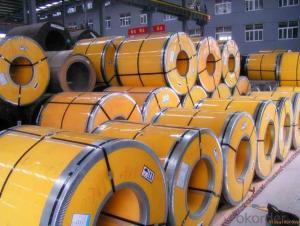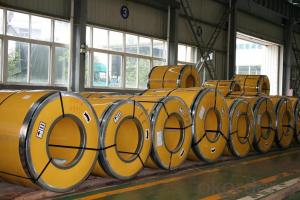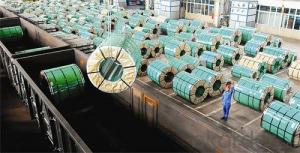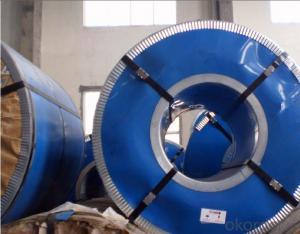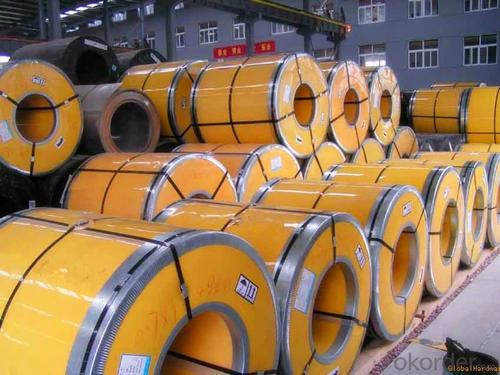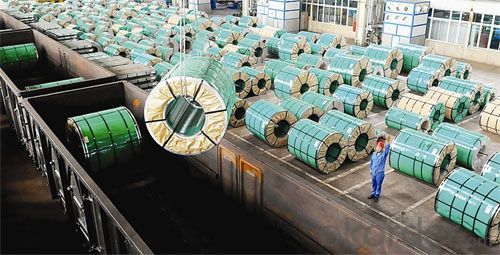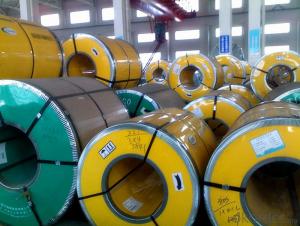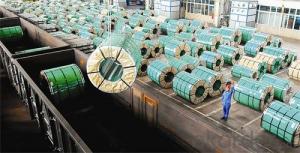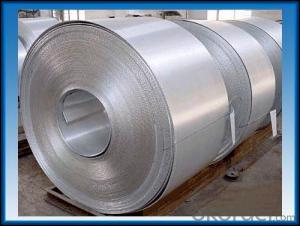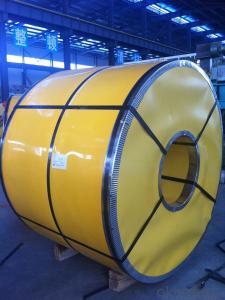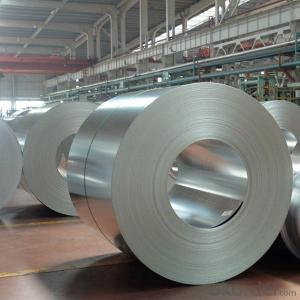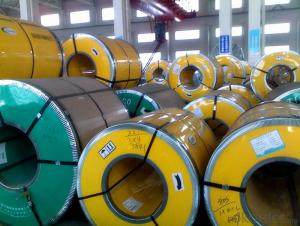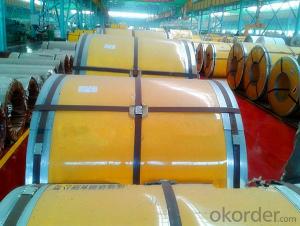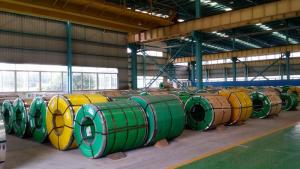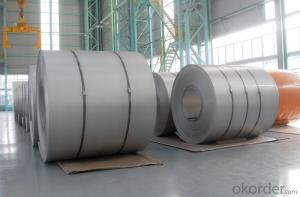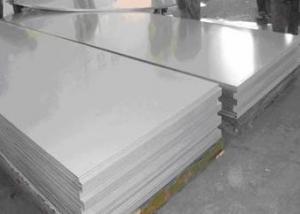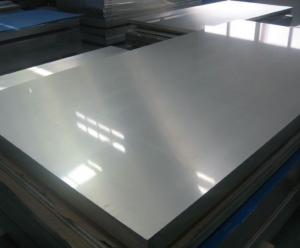Stainless Steel Strip 304 Cold Rolled 2B Finish
- Loading Port:
- Ningbo
- Payment Terms:
- TT OR LC
- Min Order Qty:
- 100 m.t.
- Supply Capability:
- 20000 m.t./month
OKorder Service Pledge
OKorder Financial Service
You Might Also Like
Cold Rolled Stainless Steel Coil 304 Grade 2B Finish
Packaging Detail: standard export packing or as customer's requirements
Delivery Detail: 7-15 days after the order
Standard: | AISI,ASTM,BS,DIN,GB,JIS | Grade: | 304 | Thickness: | 0.3-3.0mm |
Place of Origin: | China Mainland | Brand Name: | CNBM | Model Number: | 304 |
Type: | Steel Coil | Technique: | Cold Rolled | Surface Treatment: | 2B, BA |
Application: | Medical instruments, building, chemical food industry agriculture | Width: | 500-2000mm | Length: | Coil |
finish: | 2B, BA | item: | 304 cold rolled stainless steel coil | density: | 7.93 |
- Q: How do stainless steel strips perform in high-pressure steam?
- Known for their excellent performance in high-pressure steam environments, stainless steel strips have inherent resistance to corrosion and high-temperature strength, enabling them to withstand the harsh conditions associated with high-pressure steam applications. The presence of chromium in stainless steel forms a protective layer that prevents oxidation and maintains the material's integrity even at elevated temperatures. Moreover, stainless steel strips demonstrate low thermal expansion and possess remarkable mechanical properties, making them suitable for high-pressure steam systems. In conclusion, stainless steel strips guarantee the safety and efficiency of steam applications, as they are highly reliable and perform exceptionally well in high-pressure steam environments.
- Q: How do stainless steel strips compare to other materials like aluminum or carbon steel?
- Stainless steel strips offer several advantages when compared to other materials like aluminum or carbon steel. Firstly, stainless steel is highly resistant to corrosion, making it an ideal choice for applications in harsh environments or where exposure to moisture is common. This corrosion resistance is due to the presence of chromium, which forms a protective oxide layer on the surface of the steel. Additionally, stainless steel strips have excellent strength and durability, making them suitable for various structural applications. They can withstand high temperatures and exhibit good mechanical properties, such as high tensile strength and impact resistance. This makes stainless steel strips a reliable choice for industries where strength and durability are crucial, such as construction, automotive, or aerospace. Another advantage of stainless steel is its hygienic properties. It is non-porous and easy to clean, preventing the growth of bacteria or other contaminants. This makes stainless steel strips commonly used in food processing, medical equipment, or pharmaceutical industries. Moreover, stainless steel strips offer an attractive aesthetic appeal due to their smooth and shiny surface finish. They can be easily polished or brushed to achieve different visual effects, making them popular in architectural and decorative applications. In comparison, aluminum is lighter in weight than stainless steel but lacks the same level of strength and durability. Aluminum is also more prone to corrosion, especially in acidic or alkaline environments. On the other hand, carbon steel is less expensive than stainless steel but lacks the same level of corrosion resistance. Carbon steel is also more susceptible to rusting and requires regular maintenance to prevent corrosion. In summary, stainless steel strips excel in terms of corrosion resistance, strength, durability, hygienic properties, and aesthetic appeal when compared to materials like aluminum or carbon steel. However, the choice of material ultimately depends on the specific requirements of the application, considering factors such as cost, weight, and environmental conditions.
- Q: How do you measure the thickness of stainless steel strips?
- One way to measure the thickness of stainless steel strips is by using a micrometer. This handheld device allows for precise measurements by gently clamping the strip between its jaws and reading the measurement displayed on the micrometer's scale.
- Q: What are the common uses of stainless steel strips in the food packaging industry?
- Stainless steel strips find various common uses in the food packaging industry due to their unique properties and capabilities. Some of the key uses include: 1. Sealing: Stainless steel strips are often used for sealing food packaging materials such as plastic bags or containers. Their high strength and durability ensure a tight and secure seal, preventing any leakage or contamination. 2. Fastening: These strips are also used for fastening different components of food packaging machinery or equipment. Their resistance to corrosion and high temperatures makes them suitable for fastening purposes, ensuring a secure and long-lasting connection. 3. Conveyor Systems: Stainless steel strips are widely used in the construction of conveyor systems within the food packaging industry. They provide a smooth and hygienic surface for the movement of food products, ensuring cleanliness and preventing any potential contamination. 4. Support Structures: Stainless steel strips are utilized in the fabrication of support structures for food packaging machinery or equipment. Their high strength-to-weight ratio allows for the construction of sturdy and reliable support systems, ensuring stability and efficient operation. 5. Heat Transfer: Stainless steel strips are often incorporated into heat exchangers or heating systems within the food packaging industry. Their excellent thermal conductivity enables efficient heat transfer, contributing to the preservation and sterilization of food products during packaging. 6. Hygiene and Cleanliness: Stainless steel strips are highly resistant to corrosion, staining, and bacterial growth, making them ideal for applications where hygiene and cleanliness are crucial. They are widely used in food packaging machinery or equipment that comes into direct contact with food products, ensuring a safe and sanitary packaging process. In summary, stainless steel strips are versatile and essential components in the food packaging industry. Their sealing, fastening, conveyor, support, heat transfer, and hygiene properties make them invaluable for ensuring the safety, reliability, and efficiency of food packaging processes.
- Q: Are stainless steel strips suitable for chemical storage tanks?
- Yes, stainless steel strips are suitable for chemical storage tanks. Stainless steel is highly resistant to corrosion, making it ideal for storing chemicals that may be corrosive or reactive. It has excellent strength and durability, ensuring the tank can withstand the pressure and weight of the chemical contents. Additionally, stainless steel is non-porous, preventing the absorption of chemicals and avoiding contamination. It is also easy to clean and maintain, reducing the risk of cross-contamination between different chemicals. Overall, stainless steel strips provide a reliable and long-lasting solution for chemical storage tanks.
- Q: What is the maximum length available for stainless steel strips?
- The maximum length available for stainless steel strips can vary depending on the manufacturer and the specific requirements of the project. However, stainless steel strips are commonly available in lengths up to 20 feet (6.1 meters) or even longer.
- Q: Can stainless steel strips be used in the agricultural industry?
- Yes, stainless steel strips can be used in the agricultural industry. Stainless steel is known for its corrosion resistance, durability, and strength, making it suitable for various agricultural applications. Stainless steel strips can be used to fabricate equipment and components such as tanks, silos, troughs, conveyors, and machinery frames. These strips are resistant to rust and can withstand harsh environmental conditions, including exposure to moisture, chemicals, and agricultural substances. Moreover, stainless steel is easy to clean and maintain, making it a hygienic choice for applications in the agricultural industry. Overall, stainless steel strips offer numerous benefits and can be effectively utilized in various agricultural processes and equipment.
- Q: Are stainless steel strips suitable for architectural sculptures?
- Architectural sculptures can be made using stainless steel strips, which offer numerous benefits. Firstly, stainless steel is highly versatile and has several advantages for creating such sculptures. Its durability and resistance to corrosion make it perfect for outdoor sculptures that are exposed to different weather conditions. Therefore, the sculptures will maintain their aesthetic appeal and structural integrity over time. Furthermore, stainless steel has a sleek and modern appearance that can enhance the visual appeal of architectural sculptures. Its reflective surface can produce fascinating light and shadow effects, adding depth and dimension to the artwork. Additionally, stainless steel can be easily manipulated and shaped into various forms, allowing artists to create intricate and complex designs. Moreover, stainless steel is a sustainable and eco-friendly material. It is 100% recyclable, which means it can be reused and repurposed, reducing waste and contributing to a greener environment. In conclusion, stainless steel strips are a suitable choice for architectural sculptures due to their durability, aesthetic appeal, versatility, and eco-friendliness.
- Q: Are 111 stainless steel strips suitable for electrical conductivity applications?
- No, 111 stainless steel strips are not suitable for electrical conductivity applications.
- Q: Are stainless steel strips suitable for furnace parts?
- Yes, stainless steel strips are suitable for furnace parts. Stainless steel is known for its high resistance to corrosion, heat, and oxidation, making it an ideal material for furnace components that are exposed to extreme temperatures. The stainless steel strips provide excellent strength and durability, ensuring the longevity of furnace parts. Additionally, stainless steel's non-reactive nature makes it suitable for various types of furnaces, including those used for industrial, commercial, and residential purposes. Overall, stainless steel strips are a reliable and efficient choice for furnace parts.
Send your message to us
Stainless Steel Strip 304 Cold Rolled 2B Finish
- Loading Port:
- Ningbo
- Payment Terms:
- TT OR LC
- Min Order Qty:
- 100 m.t.
- Supply Capability:
- 20000 m.t./month
OKorder Service Pledge
OKorder Financial Service
Similar products
Hot products
Hot Searches
Related keywords
